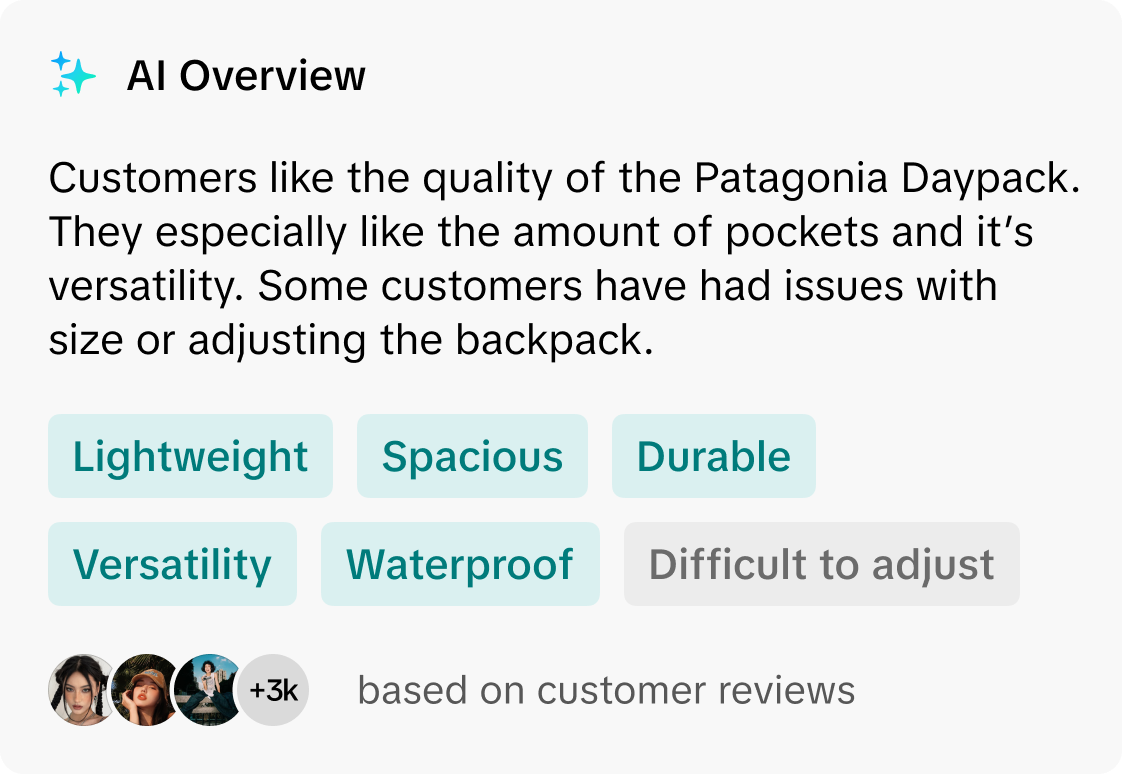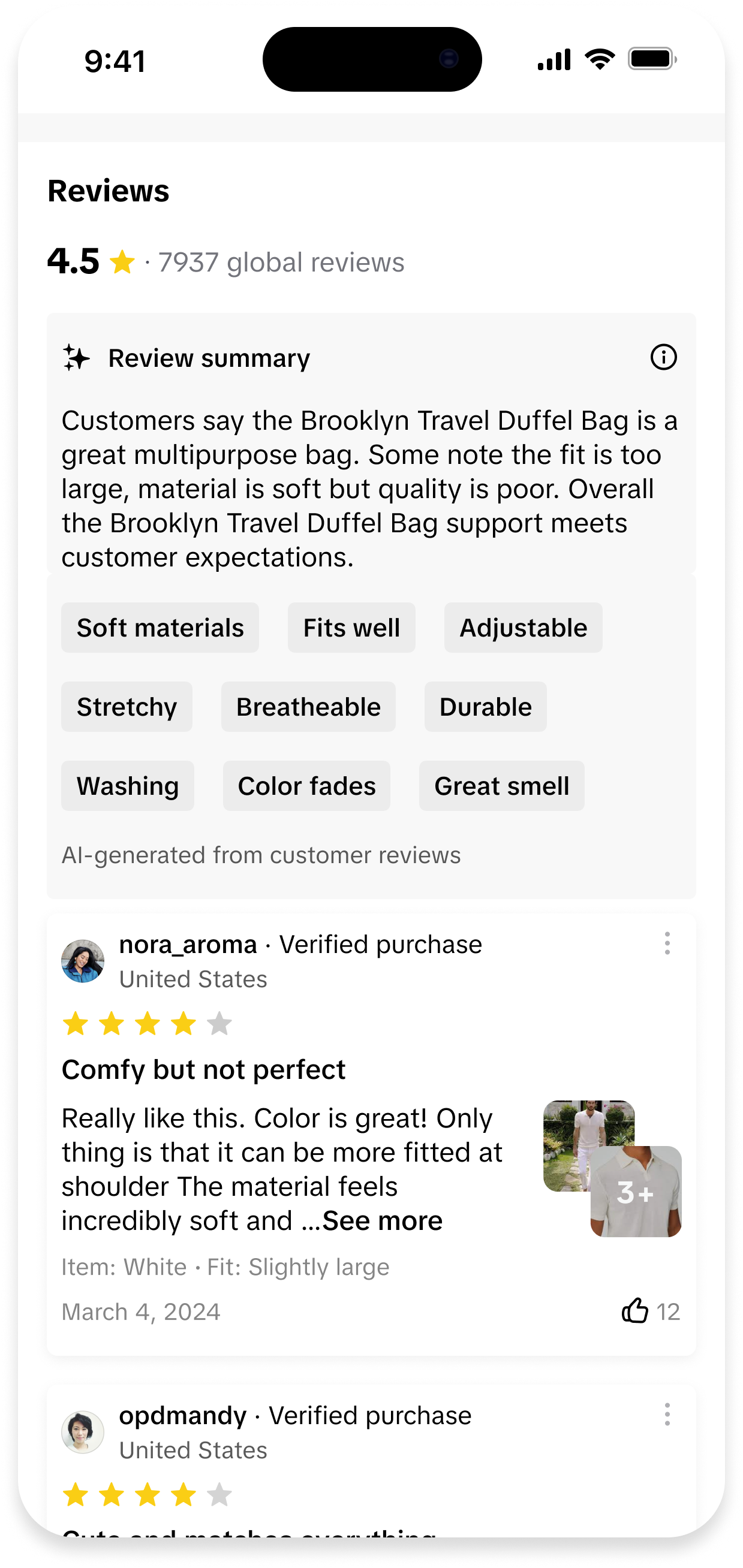From Stars
to Stories
Design Lead
2024-Present
Overview
As the design lead for TikTok Shop’s reviews team, I defined the first AI experiences for TikTok Shop. I also improved review exposure by transforming product reviews from a vertical product to a horizontal platform, ensuring scalability by spearheading a team component library that was made to integrate with the broader TikTok Shop design system.
My contributions to the team led to 14+ new projects and experiences increasing GMV (Growth Metric Value) by 2.01% ($549k per day) and reducing return rate by 3.55%.
Defining AI
The AI overview provides both a summary of recent customer reviews and pulls out key insights based on customer feedback. It’s generated 4.41% CVR contributing towards 2.41% overall GMV.
AI-powered Customer Summary
The guiding hypothesis for the AI summary is that providing users with a representative synthesis of feedback other users have submitted will allow them to more readily make an informed purchase decision, resulting in increased trust in the products they buy and in the TikTok Shop platform.
The goal of the first iteration of this project was to gather both qualitative and quantitative feedback and improve the model while slowly scaling out from 100 to 6,000 select fashion and beauty products, then all products in the fashion and beauty category.
Customer-based AI Insights
The previous display of listing customer feedback was originally designed to provide access to all comments in one surface. However, in their search users struggled to find the right customer insights to make an informed purchase decision, leading to increased drop off and return rate.
The goal of the team's first iteration was to define the guardrails of the Gen AI model, working with product and content design to understand the constraints, determine rules, iterate based on output testing, and put exploratory mockups and insights in front of customers.
Th
Envisioning reviews as a platform
In H2 2024, as reviews continued to grow as a service, the next opportunity areas quickly expanded beyond the product detail page. I identified the need for reviews to be a bridge between the core app and commerce experiences, defined how they might operate as a platform framework, and executed on core design components that scale across surfaces.
Leading the first Reviews Design Sprint
I led and organized a comprehensive design sprint that brought together 10+ cross-functional partners across product, design, and engineering, ultimately generating 60+ concepts. Thirteen of these ideas were defined and prototyped for a broader presentation involving the working team and leadership, with 6 prioritized for Q1 & Q2, making up 60% of the H1 product roadmap.
As part of this process, I implemented an approach that incorporated Figma, and Figjam brainstorming frameworks which empowered the design team to create scalable and impactful solutions. Due to the success of this effort, this approach has been adopted by peers for future sprints of varying size, driving a collaborative culture of design process, iteration, and impact.
Increasing Quantity Reviews and Ratings
The first set of projects was created to drive review ratings and detailed reviews. I delivered key concepts for quick ratings and ingresses for detailed reviews across organic and shop experiences. This helped move high impact “tipping point” quantities of reviews that push products to be higher ranked for exposure across the TikTok Shop tab, and higher search exposure.
Creating Richer Review Consumption
The latter half of explorations focused on consumption-related experiences for potential buyers to view authentic reviews with other customers on TikTok. The current experiences span the TikTok shop platform in the form of showcasing reviews with media, AI experiences, redesigning review cards, and extending all of these experiences across the platform (Is this necessary?)
Building a Scalable Component Library
The revamped reviews platform needed to establish consistent and scalable patterns to use across TikTok Shop including new components such as a media carousel of customer product reviews, as well as frequently utilized elements such as review cards. This need led me to create a reviews component library built upon the larger TikTok Shop design system to reinforce consistency throughout the platform.
Moving Towards Media First
Video reviews carousels on eligible products were prioritized as part of a project to make them more accessible as data has shown that customers are more likely to consider a product that has video and photo reviews due to the fact that they become more “authentic” and “real”.
Review and rating cards
These components, among others, were built for the review component library in collaboration with the reviews and design teams to understand all possible use cases, surfaces and publishing methods across TikTok which these may apply. These components quickly saw use across teams.
Th




